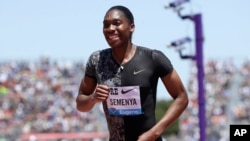Caster Semenya was named to the women's 5,000 meters on Friday, a race she chose after being banned from competing in her favored 800 meters due to rules impacting women with conditions that create excessive natural testosterone.
Semenya's inclusion on a competitor list for Eugene released by World Athletics was unexpected after she didn't make the qualifying time for the 5,000 and was not included in the South Africa team named this week for the worlds.
The 31-year-old Semenya is not expected to win a medal in the 5,000 as her personal best in the long-distance race is well off the world's leading runners. But her presence will be enough to spark more intrigue.
NBC reported Semenya was moved up onto the list for the worlds after some higher-ranked runners didn't enter the 5,000. South Africa's track federation and Semenya's representatives didn't immediately respond to requests for clarification.
If she runs, it will be the first time Semenya has appeared at a world championships or Olympics since 2017, when she won her third world title in the 800. She also has two Olympic golds over two laps but has been banned from running in races from 400 meters to one mile since 2019 under rules that exclude women who have an intersex condition called 46,XY difference in sex development.
Regulations demand the women affected undergo medical intervention to lower their natural hormone levels to below a certain threshold if they want to run in those races. The World Athletics says high testosterone gives DSD athletes an unfair advantage in female races.
Semenya and other runners who fall under the rules have declined to lower their natural testosterone and have been forced to compete in other unregulated events for the last three years.
Semenya was assigned female at birth, raised as a girl and identifies as a woman. She has never publicly identified herself as intersex — that is, having both male and female traits — or as having the 46,XY DSD condition.
However, she essentially acknowledged having the condition by appealing the DSD rules at the Court of Arbitration for Sport in 2018. She lost that case and a second appeal, and is pursuing a third challenge against the rules at the European Court of Human Rights.









